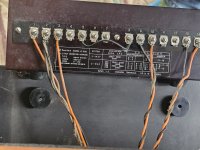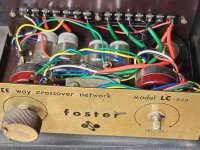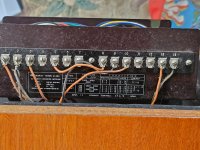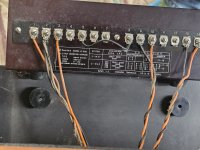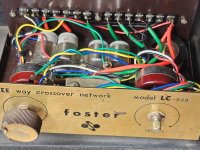Does anyone have a schematic for the Foster (also called Fostex) LC300 3 way crossover? I have a pair of Goodman's speakers with the Foster crossover. I want to rewire the speaker and don't know which connections go where.
Thank you
Ian
Thank you
Ian
I couldn't find the circuit using Google.
Are you familiar enough with different components & wiring to draw the circuit > even if you can't read all the values?
Are you familiar enough with different components & wiring to draw the circuit > even if you can't read all the values?
I'll try but I wouldn't be surprised if I muck it up.
Would a photo help? - I've opened up the crossover and can see the components reasonably clearly.
Would a photo help? - I've opened up the crossover and can see the components reasonably clearly.
I didn't actually realize that it was 'enclosed'.
A photo of both the component side AND the underside could probably help me and many others to advise you further.
Even posting some values you can read might help 🙂
A photo of both the component side AND the underside could probably help me and many others to advise you further.
Even posting some values you can read might help 🙂
Here are pictures of the Foster LC300. I think i can put the power amplifier output directly into the terminal board. (?? Nos. 1 and 2??)
I wasn't able to remove the capacitors to get values, because my socket wouldn't get into the space available. The two (i suspect they're wire wound) pots are 8 ohms each. I think they might be unnecessary unless they affect the roll off characteristics.
I wasn't able to remove the capacitors to get values, because my socket wouldn't get into the space available. The two (i suspect they're wire wound) pots are 8 ohms each. I think they might be unnecessary unless they affect the roll off characteristics.
Attachments
I see 😕
That looks like a very old unit. There are certainly lots of connectors (and wires) - not quite what I expected.
I see quite a lot of labeling on the rear > does this not explain some information?
The 'wire wound pots' you see would actually be something called L-pads and are used as volume controls for the midrange and tweeter.
I am 99% sure this is a three way crossover. The labeling of the L-pads as 8 ohms indicates this unit is meant for 8 ohm speakers.
This might be relevant & helpful, but I'm not sure (?)
https://www.google.com/search?q=foster+l300+manual+pdf&sca_esv=b3743c3edb8cdec9&sxsrf=AHTn8zoWgv-czB0FbiNENRUHqS46_DM8dQ:1745549122082&source=hp&ei=QvcKaPH3Apmjvr0PtZHboQY&iflsig=ACkRmUkAAAAAaAsFUko2zBlIEBPq8qiFt2RDfNYP72BA&oq=foster+L300+manual&gs_lp=Egdnd3Mtd2l6GgIYAiISZm9zdGVyIEwzMDAgbWFudWFsKgIIADIFECEYoAFIuOoBUABY89QBcAB4AJABAJgBlQKgAbcgqgEGMC4xMi44uAEByAEA-AEBmAIToAKmIcICBBAjGCfCAhYQLhiABBixAxjRAxhDGIMBGMcBGIoFwgIIEAAYgAQYiwPCAgUQABiABMICCxAuGIAEGLEDGIMBwgIOEC4YgAQYsQMY0QMYxwHCAhcQLhiABBixAxiDARjHARiKBRiOBRivAcICCxAAGIAEGJECGIoFwgIIEAAYgAQYsQPCAh0QLhiABBixAxiDARimAxjHARioAxiLAxiOBRivAcICCxAAGIAEGLEDGIsDwgIUEC4YgAQYsQMYgwEYqAMYiwMYnQPCAg4QLhiABBjHARiOBRivAcICBRAuGIAEwgIOEC4YgAQYsQMYxwEYrwHCAhEQLhiABBixAxjRAxiDARjHAcICFxAuGIAEGKYDGMcBGKgDGIsDGI4FGK8BwgILEC4YgAQYxwEYrwHCAhcQLhiABBixAxiDARikAxioAxiKBRiLA8ICFBAuGIAEGKYDGMcBGKgDGIsDGK8BwgIGEAAYFhgewgILEAAYgAQYhgMYigXCAggQABiABBiiBMICBRAAGO8FwgICECbCAgYQABgHGB7CAgQQABgewgIGEAAYCBgewgIIEAAYBxgIGB7CAggQABiiBBiJBcICBBAhGBXCAgcQIRigARgKmAMAkgcGMC40LjE1oAehpQGyBwYwLjQuMTW4B6Yh&sclient=gws-wiz
PS.
If you only have one unit, what project were you thinking of?
If it is actually a stereo crossover then the L-pads would be for tweeter volume only.
That looks like a very old unit. There are certainly lots of connectors (and wires) - not quite what I expected.
I see quite a lot of labeling on the rear > does this not explain some information?
The 'wire wound pots' you see would actually be something called L-pads and are used as volume controls for the midrange and tweeter.
I am 99% sure this is a three way crossover. The labeling of the L-pads as 8 ohms indicates this unit is meant for 8 ohm speakers.
This might be relevant & helpful, but I'm not sure (?)
https://www.google.com/search?q=foster+l300+manual+pdf&sca_esv=b3743c3edb8cdec9&sxsrf=AHTn8zoWgv-czB0FbiNENRUHqS46_DM8dQ:1745549122082&source=hp&ei=QvcKaPH3Apmjvr0PtZHboQY&iflsig=ACkRmUkAAAAAaAsFUko2zBlIEBPq8qiFt2RDfNYP72BA&oq=foster+L300+manual&gs_lp=Egdnd3Mtd2l6GgIYAiISZm9zdGVyIEwzMDAgbWFudWFsKgIIADIFECEYoAFIuOoBUABY89QBcAB4AJABAJgBlQKgAbcgqgEGMC4xMi44uAEByAEA-AEBmAIToAKmIcICBBAjGCfCAhYQLhiABBixAxjRAxhDGIMBGMcBGIoFwgIIEAAYgAQYiwPCAgUQABiABMICCxAuGIAEGLEDGIMBwgIOEC4YgAQYsQMY0QMYxwHCAhcQLhiABBixAxiDARjHARiKBRiOBRivAcICCxAAGIAEGJECGIoFwgIIEAAYgAQYsQPCAh0QLhiABBixAxiDARimAxjHARioAxiLAxiOBRivAcICCxAAGIAEGLEDGIsDwgIUEC4YgAQYsQMYgwEYqAMYiwMYnQPCAg4QLhiABBjHARiOBRivAcICBRAuGIAEwgIOEC4YgAQYsQMYxwEYrwHCAhEQLhiABBixAxjRAxiDARjHAcICFxAuGIAEGKYDGMcBGKgDGIsDGI4FGK8BwgILEC4YgAQYxwEYrwHCAhcQLhiABBixAxiDARikAxioAxiKBRiLA8ICFBAuGIAEGKYDGMcBGKgDGIsDGK8BwgIGEAAYFhgewgILEAAYgAQYhgMYigXCAggQABiABBiiBMICBRAAGO8FwgICECbCAgYQABgHGB7CAgQQABgewgIGEAAYCBgewgIIEAAYBxgIGB7CAggQABiiBBiJBcICBBAhGBXCAgcQIRigARgKmAMAkgcGMC40LjE1oAehpQGyBwYwLjQuMTW4B6Yh&sclient=gws-wiz
PS.
If you only have one unit, what project were you thinking of?
If it is actually a stereo crossover then the L-pads would be for tweeter volume only.
Last edited:
These are three way speakers. I have two of them. Ie a stereo pair. The tweeters are Trebax 100, the midrange units are Midax 95 horns and the bass units are Axiom 300. There's no information on the components that I can see but there is information on the connections, which I have now labelled. I'll endeavour to remove the components and change the caps. They'll probably be dried out by now. There was a mass of dirt on them. I believe they haven't been used for at least 50 years - maybe 60..
Unfortunately, for some reason, I couldn't download any of the files you provided the link for. Are you able to send them to me directly?
People tell me that these three Goodmans drivers are "Nirvana heavenly good" and because of this I want to try and get them working well.
I greatly appreciate you spending time helping me. I'm sure that speakers are going to be worth the effort.
Thank you,
Ian
Unfortunately, for some reason, I couldn't download any of the files you provided the link for. Are you able to send them to me directly?
People tell me that these three Goodmans drivers are "Nirvana heavenly good" and because of this I want to try and get them working well.
I greatly appreciate you spending time helping me. I'm sure that speakers are going to be worth the effort.
Thank you,
Ian
Attachments
WOW >
I was looking at your 'rare & special' drivers > I hope they are all in perfect working order 🙂
It is my thinking that rather than replacing capacitors of an old crossover - that may be only a 6bB per octave type,
you could do better by buying new crossovers that are 12dB per octave (second order) which the tweeters WILL need.
Here is an example of some products you could consider.
[ I was particularly looking at the fifth from the top which appears to include some tweeter attenuation - which you will need ]
https://www.ebay.com.au/sch/i.html?...sacat=0&_from=R40&_trksid=p4432023.m570.l1313
I was looking at your 'rare & special' drivers > I hope they are all in perfect working order 🙂
It is my thinking that rather than replacing capacitors of an old crossover - that may be only a 6bB per octave type,
you could do better by buying new crossovers that are 12dB per octave (second order) which the tweeters WILL need.
Here is an example of some products you could consider.
[ I was particularly looking at the fifth from the top which appears to include some tweeter attenuation - which you will need ]
https://www.ebay.com.au/sch/i.html?...sacat=0&_from=R40&_trksid=p4432023.m570.l1313
Was that this one:-
(250W 4-80 Three-way Crossover Speaker Audio Bass Frequency Divider Brand new
AU $62.47 or Best Offer +AU $13.73 postage)? It might not work as the speaker drivers are all 15 ohms, as I understand. I was thinking about replacing the crossovers for some new ones, so I love your idea and 12db/octave should give better distribution to each driver. The point you make "I hope the drivers are in good condition"... Yes, that thought crossed my mind too. As far as I can tell from Goodman's "Axiom Experts" - they tell me that they last for forever and a day. The cabinet is a home made one and getting into it will be a royal pain. I think the crossovers should be addressed first. If the speakers still sounds crappy, I'll have to get the drill out and start drilling out the cabinet screws (i think they been put in with Locktite). Since the drivers are 15 ohms, could you recommend another crossover that would work with this setup? Incidentally, my amplifiers are Verdik 10 watt tube amps. At the moment, I'm using a Lux PZ 24 preamp (made in the late 60s) but when I get them repaired, I'll be using genuine Verdik preamplifiers. Apparently, these speakers are sound 100db per watt, so the 10 watt tube amps should be fine. I have a Thorens TD124 Mk2 turntable and a Yamaha CD player (that weighs 20kg. - 44lbs), a Nakamichi Tri-Tracer cassette player, a Nagra lVs TC reel to reel and a Ferrograph and Revox reel to reel (tube) tape recorders. I have other equipment in another room but I have this unrequited love affair with old audio equipment. I collect them like some people collect cute stray dogs that are missing one leg..
Best wishes,
Ian
(250W 4-80 Three-way Crossover Speaker Audio Bass Frequency Divider Brand new
AU $62.47 or Best Offer +AU $13.73 postage)? It might not work as the speaker drivers are all 15 ohms, as I understand. I was thinking about replacing the crossovers for some new ones, so I love your idea and 12db/octave should give better distribution to each driver. The point you make "I hope the drivers are in good condition"... Yes, that thought crossed my mind too. As far as I can tell from Goodman's "Axiom Experts" - they tell me that they last for forever and a day. The cabinet is a home made one and getting into it will be a royal pain. I think the crossovers should be addressed first. If the speakers still sounds crappy, I'll have to get the drill out and start drilling out the cabinet screws (i think they been put in with Locktite). Since the drivers are 15 ohms, could you recommend another crossover that would work with this setup? Incidentally, my amplifiers are Verdik 10 watt tube amps. At the moment, I'm using a Lux PZ 24 preamp (made in the late 60s) but when I get them repaired, I'll be using genuine Verdik preamplifiers. Apparently, these speakers are sound 100db per watt, so the 10 watt tube amps should be fine. I have a Thorens TD124 Mk2 turntable and a Yamaha CD player (that weighs 20kg. - 44lbs), a Nakamichi Tri-Tracer cassette player, a Nagra lVs TC reel to reel and a Ferrograph and Revox reel to reel (tube) tape recorders. I have other equipment in another room but I have this unrequited love affair with old audio equipment. I collect them like some people collect cute stray dogs that are missing one leg..
Best wishes,
Ian
If you have a simple multimeter that measures DC ohms, tell me what each speaker/driver measures.
If in fact they are 15 ohms, I would be happy to draw you a crossover design that would basically suit.
PS.
The Ebay crossover I was referring to has 'Free delivery' and a cost of > AU $56.63 [ it shows a logo "Alice1101983 ]
If in fact they are 15 ohms, I would be happy to draw you a crossover design that would basically suit.
PS.
The Ebay crossover I was referring to has 'Free delivery' and a cost of > AU $56.63 [ it shows a logo "Alice1101983 ]
Last edited:
The tweeter is showing 8.5 ohms and the midax (midrange horn)and Axiom (woofer)show 11.5 ohms. Woukd the capacitors not influence this? I made sure that the trains I took were instant readings - hopefully not allowing the capacitors to charge up.
Below are the characteristics I've gleaned by using Gemini:-
I may have to post details in multiple parts, if there's a limit on the characters
Below are the characteristics I've gleaned by using Gemini:-
I may have to post details in multiple parts, if there's a limit on the characters
- Trebax
- Type: Horn tweeter.
- Frequency Response: Typically extended into the higher frequencies, offering a bright and detailed sound signature.
- Impedance: Varies depending on the specific Trebax 100 model, but generally compatible with common amplifier output impedances (e.g., 8 ohms, 4 ohms).
- Sensitivity: Ranges from 85 dB to 90 dB (1 watt, 1 meter), depending on the specific model.
- Power Handling: Ranges from 10 watts to 25 watts RMS, depending on the model.
- Tweeter Material: Typically utilizes a horn constructed from a durable, acoustic material designed to project the high frequencies.
Goodmans Midax 95 is a type of horn used in audio systems, particularly in guitar amplifiers. Its key specifications include a frequency range of 650-8000 Hz, a crossover frequency of 950-5000 Hz, a 25W system handling capacity (50W in the USA), 15 ohms impedance, and specific baffle cut-out and mounting hole dimensions.
Here's a more detailed breakdown:
Frequency Range: 650-8000 Hz
Crossover Frequency: 950-5000 Hz
System Handling Capacity: 25W (50W in the USA)
Impedance: 15 ohms
Here's a more detailed breakdown:
Frequency Range: 650-8000 Hz
Crossover Frequency: 950-5000 Hz
System Handling Capacity: 25W (50W in the USA)
Impedance: 15 ohms
Goodmans Axiom 300
Frequency range of 30-16,000 Hz. It has a power handling of 20 Watts (40 Watts in the USA). The speaker has a voice coil diameter of 1.73" (4.4 cm) and an impedance of 15-16 ohms or 8 ohms. The overall diameter is 12" (31.2 cm) and the depth is 6.1" (15.9 cm).
Here's a more detailed breakdown of the specifications:
General:
Frequency range of 30-16,000 Hz. It has a power handling of 20 Watts (40 Watts in the USA). The speaker has a voice coil diameter of 1.73" (4.4 cm) and an impedance of 15-16 ohms or 8 ohms. The overall diameter is 12" (31.2 cm) and the depth is 6.1" (15.9 cm).
Here's a more detailed breakdown of the specifications:
General:
- Frequency Range: 30-16,000 Hz
- Power Handling: 20 Watts (40 Watts in the USA)
- Overall Diameter: 12" (31.2 cm)
- Overall Depth: 6.1" (15.9 cm)
- Nett Weight: 17 lbs 5 ozs (7.85 kg)
I'm a little confused by what you've written here. Did you take these measurements with the drivers connected to the Foster crossover ?The tweeter is showing 8.5 ohms and the midax (midrange horn)and Axiom (woofer)show 11.5 ohms. Woukd the capacitors not influence this? I made sure that the trains I took were instant readings - hopefully not allowing the capacitors to charge up.
( probably a type-O , but I don't know what you mean using the word "trains" )
I need you to measure the resistance at the individual speaker terminals without them connected to anything else.
Also, while your at it, briefly connect a 1.5 volt battery to the terminals of each driver to check if you get a 'click/pop' sound from each one.
PS.
So that I best know how to communicate effectively, it occurred to me that I should ask you a few questions to 'roughly gauge' your electronics knowledge.
Have you ever built anything with parts and a soldering iron?
Did you know that the coper coils you see in a crossover are also called inductors?
If you were to connect one single component to the terminals of a woofer, do you understand the difference between series and parallel?
Did you know that regular polarized electrolytic capacitors are never used in a crossover network?
Also, could post a picture or two of your drivers so that all can see 🙂
I forgot to ask >
Do your tube amps have a single positive output or a selection, like 4 , 8 and 16 ohms ?
Do your tube amps have a single positive output or a selection, like 4 , 8 and 16 ohms ?
I'll upload some photos of the drivers this afternoon. Yesterday, I took the readings from the crossovers, today, I gained access to the actual drivers and I was able to measure the resistance of the driver when it was disconnected. The Trebex tweeters say 15 ohms but have a resistance of 8.5 ohms, when measured by my multimeter, which is a Fluke ie a good make. The other drivers all come in at about 12.5 ohms but day "15 ohms" on them. The connections to all the drivers were poor and I wouldn't be surprised if that affected things. I'm going to clean up and tighten all connections, then try the speakers again. The baffle board was held in on each speaker by about 30 heavy screws (wow..). I should get the photos through in about 3 hours or so. Although I'm a medical (GP) I used to be a mechanical engineer. I have rudimentary electrical skills, but my practical skills in electronics are very basic.
Ian
Ian
A friend is going to lend me an amplifier, to test out these speakers. I opened up the cabinets (a much harder task than i had ever imagined) and the woofer is different in each speaker. (A 12" Goodmans Axiom 300 in one speaker and a 12" Audiom 51 in the other). It could be that the sound issues I'm having is due to the mixed drivers and not the crossovers? I'll let the DIYAudio group know what transpires.
In addition to this, one loudspeaker sounds louder than the other. At first I put this down to the crossovers, but I changed the crossovers from one speaker to the other and the loudspeaker that sounded louder, still sounded louder. I directly measured the resistance of each driver unit and they were slightly different ie:-
Trebax (tweeter) 8.5 ohms on one 9.5 ohms on the other.(yet both were labelled "15 ohms".
Midax 11.5 ohms on both speakers (labelled 15 ohms)
Axiom 300 12", 11.5 ohms - labelled 15 ohms on the "louder" speaker.
Audiom 51 (12") 14 ohms on the "less loud" speaker. The louder speaker sounds "brighter", irrespective of which crossover is used.
I measured the resistances with the speaker drivers disconnected from the crossovers. The capacitors in both crossovers looked physically good. (No swelling, no weeping, no charring). I know one can't accurately determine the excellence of a capacitor from its appearance but my experience has been that a failing capacitor often shows some physical signs of deterioration. The caps in both the crossovers look quite normal. (As do the inductors, resistors and solder joints).
I'm now of the opinion that the drivers themselves are mismatched and this is causing the problem. I suspect the issue is irredeemable - but a proper live listening test with a good source material and good amplifier is called for.
I'll keep the group informed - as this has been a huge learning experience for me and, if nothing else, a very intriguing issue. I'm case anyone is interested, I had a hearing test about one year ago and my hearing is normal and I can hear frequencies up to 15,000 hz
I'm most definitely interested to hear the group's (or anyone's) opinions and/or suggestions. I've been told by many people that the Trebex/Midax/Axiom combination is the sound standard that many high end hifi systems can be judged by. Sadly, I had huge expectations for these speakers. I haven't actually given up on them but I didn't adequately remember the old adage " Never meet your heroes..."
Maybe my expectations were too coloured by the glowing (historical) reviews I've read over the years. Maybe these speakers, just like everything else on earth, have suffered from the inexorable ravages of time, humidity, temperature, magnetic flux and metal work hardening.
"OMNIA SUNT TEMPORARIA"
Ian
In addition to this, one loudspeaker sounds louder than the other. At first I put this down to the crossovers, but I changed the crossovers from one speaker to the other and the loudspeaker that sounded louder, still sounded louder. I directly measured the resistance of each driver unit and they were slightly different ie:-
Trebax (tweeter) 8.5 ohms on one 9.5 ohms on the other.(yet both were labelled "15 ohms".
Midax 11.5 ohms on both speakers (labelled 15 ohms)
Axiom 300 12", 11.5 ohms - labelled 15 ohms on the "louder" speaker.
Audiom 51 (12") 14 ohms on the "less loud" speaker. The louder speaker sounds "brighter", irrespective of which crossover is used.
I measured the resistances with the speaker drivers disconnected from the crossovers. The capacitors in both crossovers looked physically good. (No swelling, no weeping, no charring). I know one can't accurately determine the excellence of a capacitor from its appearance but my experience has been that a failing capacitor often shows some physical signs of deterioration. The caps in both the crossovers look quite normal. (As do the inductors, resistors and solder joints).
I'm now of the opinion that the drivers themselves are mismatched and this is causing the problem. I suspect the issue is irredeemable - but a proper live listening test with a good source material and good amplifier is called for.
I'll keep the group informed - as this has been a huge learning experience for me and, if nothing else, a very intriguing issue. I'm case anyone is interested, I had a hearing test about one year ago and my hearing is normal and I can hear frequencies up to 15,000 hz
I'm most definitely interested to hear the group's (or anyone's) opinions and/or suggestions. I've been told by many people that the Trebex/Midax/Axiom combination is the sound standard that many high end hifi systems can be judged by. Sadly, I had huge expectations for these speakers. I haven't actually given up on them but I didn't adequately remember the old adage " Never meet your heroes..."
Maybe my expectations were too coloured by the glowing (historical) reviews I've read over the years. Maybe these speakers, just like everything else on earth, have suffered from the inexorable ravages of time, humidity, temperature, magnetic flux and metal work hardening.
"OMNIA SUNT TEMPORARIA"
Ian
Yes Ian,
Not exactly the situation you would have hoped for 🙁
The DC resistance of the Midax drivers is quite normal and would indicate that they are 'nominal 15 ohm units' in their frequency range.
The different resistance of the Trebax tweeters probably indicates that one is louder than the other.
With your friend you will be able to determine if any drivers have age/damage distortion.
If the speakers were in my hands, I would take-on a personal challenge to 'match' the loudness & tonal character of both speakers
using individual customized crossover networks. This would be quite complex and just can't be done at a distance with just words.
Like you, I will be interested to see posts by other members.
Cheers
Not exactly the situation you would have hoped for 🙁
The DC resistance of the Midax drivers is quite normal and would indicate that they are 'nominal 15 ohm units' in their frequency range.
The different resistance of the Trebax tweeters probably indicates that one is louder than the other.
With your friend you will be able to determine if any drivers have age/damage distortion.
If the speakers were in my hands, I would take-on a personal challenge to 'match' the loudness & tonal character of both speakers
using individual customized crossover networks. This would be quite complex and just can't be done at a distance with just words.
Like you, I will be interested to see posts by other members.
Cheers
The first step in going to do is to put sound into each driver individually and try and determine if one of the driver's voice coils has swollen. The vpuce coil air gap is absolutely tiny and if the coil wire lacquer has deteriorated, alterations in the diameter could easily have happened. That test is scheduled for Wednesday evening. If the Midax or trebax have "friction issues", i'm going to stop there and then. I've been offered a pair of Audiom 652 bass drivers (12") to put in the cabinets, instead of the mismatched Axiom/Audiom drivers. These won't be as good as the Axiom 300 drivers but they're, at least, likely to be matched. The fact that one speaker sounds "brighter" than the other worries me - because that suggests the Midax on one of them is "dodgy" and that, for me, will be where I get off the bus.
I'll let you know on Thursday or Friday.
Ian
I'll let you know on Thursday or Friday.
Ian
- Home
- Member Areas
- Introductions
- Foster (Fostex) LC300 Crossover Schematic

